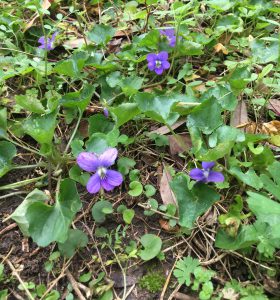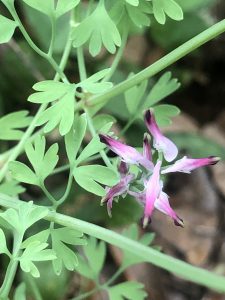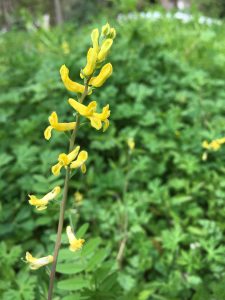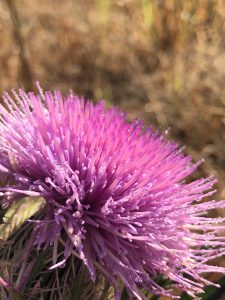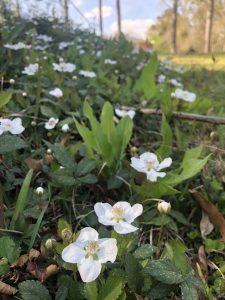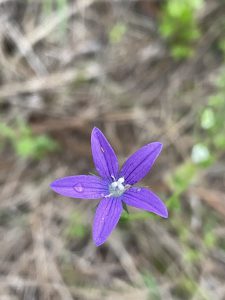Hopefully, you are enjoying No Mow March. With the extra time provided by not mowing, you can spend more time trying to observe the diverse array of flowering plants coming up in your lawn. Often these are considered weeds, but a weed is just a plant you don’t like growing where you don’t want it. However, if we can find some beauty in these plants and appreciation for their role in supporting wildlife, then maybe we can turn it around and start thinking of them as wildflowers. As a trained botanist, I’m interested in all the flowers and think of how they grow, what eats them, what pollinates them, how their seeds are dispersed, and what niche do they fill in the ecosystem, even if that ecosystem is my residential landscape. Below are a couple of my favorite plants that come up in my infrequently mowed and/or unmowed lawn during the early spring.
Early Violet (Viola palmata)
This is the one that got me started leaving areas of the yard unmowed or infrequently mowed. Those violet-colored flowers were just too pretty to mow over, and I began giving them a wide berth. Now, I have little meadows of these native violets that spring up every year and give me great pleasure to observe.
Earthsmoke (Fumaria officinalis)
Not only is this one pretty, but it has one of the coolest common names of a plant that I know of. This non-native relative of the poppy plant has delicate foliage, reminiscent of the native columbine, with flowers mostly a light purple, but with a touch of dark purple towards the tips. The flowers also have a strange little twist to them. Part of my fondness for this plant is also tied to a memory from college. I was learning how to use dichotomous keys at the time and was so proud to have successfully keyed this one out. My identification was confirmed by our taxonomy professor, who I greatly admired, and I think he was a little proud of me, too!
Smallflower Fumewort (Corydalis micrantha subsp. australis)
This one is related to earthsmoke, but in a different genus and just happens to be a native. It also has similar delicate foliage and a twist in the flowers, but these come in yellow.
Mock Bishopsweed (Ptilimnium capillaceum)
This native carrot family relative, with small flower clusters and delicate, wispy leaves, is not one that jumps out at you as being super showy. However, being a carrot relative, it is a great larval host plant for the swallowtail butterflies.
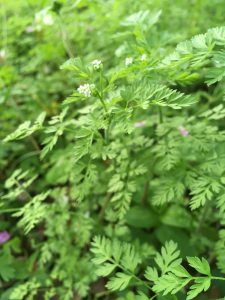
Horrid Thistle (Cirsium horridulum)
The common name says everything about how most people view thistles. Thistles definitely get a bad reputation due to those spiny leaves, but our six native species are a boon for pollinators. Being in the Aster family with many flowers grouped together, it provides lots of easily accessible pollen and nectar resources. This one is also a known host plant for the little metalmark and painted lady butterflies, which somehow find their way around all of those spines. I really enjoy the artistic symmetry of the leaves, and also the spines that surround the flower in bud, especially when the dew has collected on it and the light hits it just right.
Southern Dewberry (Rubus trivialis)
Probably another hard sell for leaving in the yard, but this prickly native plant rewards animals, including us, with delicious fruit. This one is best left in a low trafficked area where it won’t grab you.
Venus’ Looking Glass (Triodanis perfoliata)
This native beauty ties for second coolest common name, which is a reference to the shiny covering of the seed. Related to bellflowers and lobelias, Venus’ looking glass shoots up in the early spring and has beautiful purple blooms atop a wispy inflorescence (flower stalk). You’ll find several pollinators visiting this lovely little wildflower.
No Mow March is a perfect opportunity to spend time learning more about the non-turf species living in your lawn. There’s a lot more than the list above and your local extension office can help you identify what you’re seeing. You can also use the iNaturalist app for help in identifying these little pretties. If you use iNaturalist during March, please add them to our No Mow March project. For more information on No Mow March, please visit https://sfyl.ifas.ufl.edu/escambia/lawn-and-garden/no-mow-march/.
- Let Extension Diagnose Your Landscape Issues - May 28, 2025
- No Mow March 2025! - February 27, 2025
- New Year’s Resolution Ideas for Gardeners - January 16, 2025

